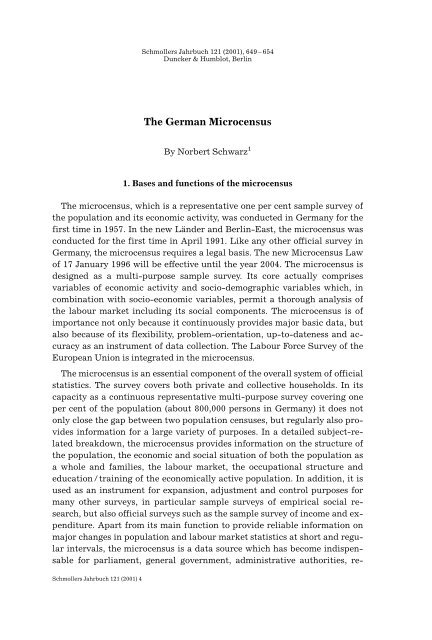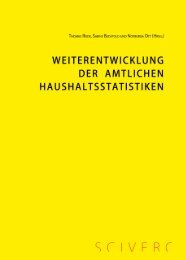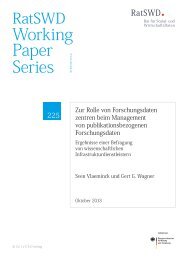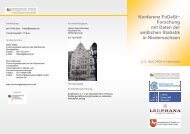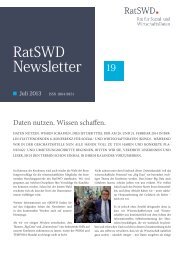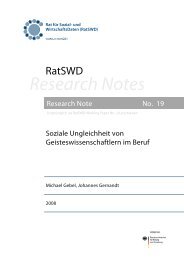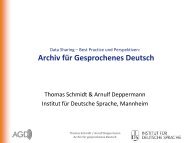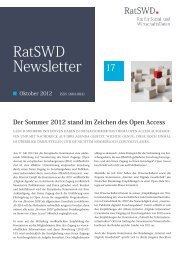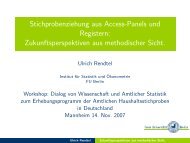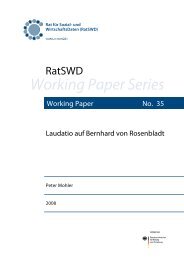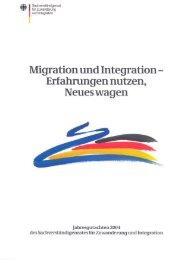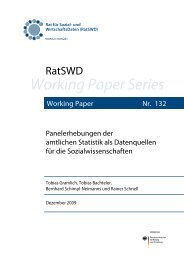The German Microcensus - RatSWD
The German Microcensus - RatSWD
The German Microcensus - RatSWD
Create successful ePaper yourself
Turn your PDF publications into a flip-book with our unique Google optimized e-Paper software.
Schmollers Jahrbuch 121 (2001), 649 ± 654<br />
Duncker & Humblot, Berlin<br />
<strong>The</strong> <strong>German</strong> <strong>Microcensus</strong><br />
By Norbert Schwarz 1<br />
1. Bases and functions of the microcensus<br />
<strong>The</strong> microcensus, which is a representative one per cent sample survey of<br />
the population and its economic activity, was conducted in <strong>German</strong>y for the<br />
first time in 1957.In the new LaÈnder and Berlin-East, the microcensus was<br />
conducted for the first time in April 1991.Like any other official survey in<br />
<strong>German</strong>y, the microcensus requires a legal basis.<strong>The</strong> new <strong>Microcensus</strong> Law<br />
of 17 January 1996 will be effective until the year 2004.<strong>The</strong> microcensus is<br />
designed as a multi-purpose sample survey.Its core actually comprises<br />
variables of economic activity and socio-demographic variables which, in<br />
combination with socio-economic variables, permit a thorough analysis of<br />
the labour market including its social components.<strong>The</strong> microcensus is of<br />
importance not only because it continuously provides major basic data, but<br />
also because of its flexibility, problem-orientation, up-to-dateness and accuracy<br />
as an instrument of data collection.<strong>The</strong> Labour Force Survey of the<br />
European Union is integrated in the microcensus.<br />
<strong>The</strong> microcensus is an essential component of the overall system of official<br />
statistics.<strong>The</strong> survey covers both private and collective households.In its<br />
capacity as a continuous representative multi-purpose survey covering one<br />
per cent of the population (about 800,000 persons in <strong>German</strong>y) it does not<br />
only close the gap between two population censuses, but regularly also provides<br />
information for a large variety of purposes.In a detailed subject-related<br />
breakdown, the microcensus provides information on the structure of<br />
the population, the economic and social situation of both the population as<br />
a whole and families, the labour market, the occupational structure and<br />
education / training of the economically active population.In addition, it is<br />
used as an instrument for expansion, adjustment and control purposes for<br />
many other surveys, in particular sample surveys of empirical social research,<br />
but also official surveys such as the sample survey of income and expenditure.Apart<br />
from its main function to provide reliable information on<br />
major changes in population and labour market statistics at short and regular<br />
intervals, the microcensus is a data source which has become indispensable<br />
for parliament, general government, administrative authorities, re-<br />
Schmollers Jahrbuch 121 (2001) 4
650 Norbert Schwarz<br />
search institutes and the general public at both the national and international<br />
level.<br />
Integrated into the microcensus, the common annual Labour Force Survey<br />
to be conducted in all countries of the European Union in the framework of<br />
European cooperation can be carried out in an effective way in line with the<br />
<strong>German</strong> system.<strong>The</strong> European Union regards the survey as a unique and indispensable<br />
instrument in preparing the Union's programmes of action in<br />
the areas of employment, unemployment, long-term unemployment and<br />
professional or vocational training and also for the purposes of regional, social<br />
and economic policies.<strong>The</strong> main objective of the Union's Labour Force<br />
Survey is the availability of harmonised and reliable statistics for taking<br />
measures regarding the labour market.<br />
2. <strong>Microcensus</strong> concept<br />
<strong>The</strong> sampling fraction for the basic programme and numerous variables<br />
of the supplementary programme has to be as large as 1% since the data of<br />
the basic programme are subject to high accuracy requirements.In addition,<br />
the sampling frame has to be that large in order to meet the demand<br />
for regionalised data.<strong>The</strong> sampling fraction is smaller for variables which<br />
are neither included in the basic programme nor are subject to deep regionalisation.A<br />
result of this requirement is a disproportionate sampling<br />
fraction of 0.45% for variables of the Labour Force Survey of the European<br />
Union.<br />
<strong>The</strong> microcensus is based on the reference week concept.Typically, the reference<br />
week of the microcensus is a week without public holidays in April.<br />
<strong>The</strong> interviews, which are conducted by interviewers commissioned by the<br />
statistical offices of the LaÈnder, usually take place in May or June.Interviews<br />
are done by written response and oral response to the questions posed<br />
by an interviewer.<strong>The</strong> aim of using this combination of methods is to guarantee<br />
the respondents' right to self-determination.Face to face interviews<br />
are the most adequate instrument to achieve a high response rate and good<br />
data quality.Through direct contact with an interviewer, the respondents<br />
can be better informed about the use and purpose of the survey.In addition,<br />
the interviewer can directly respond to questions that might come up.<br />
Compulsory response to most questions is an important factor contributing<br />
to a low level of non-response.What is also done to minimise non-response<br />
is that interviewers several times repeat their visits to those persons<br />
to be interviewed whom they did not meet during their first visit.In addition,<br />
an instrument to keep unit non-response low is the option to respond<br />
Schmollers Jahrbuch 121 (2001) 4
<strong>The</strong> <strong>German</strong> <strong>Microcensus</strong> 651<br />
in writing.Unit non-response amounts to about 3%, while item non-response<br />
is up to 25% for questions with voluntary response.<br />
<strong>The</strong> sample design of the microcensus, which the EU Labour Force Survey<br />
is a subsample of, is based on area sampling (sample districts).<strong>The</strong> current<br />
sampling frame used for the former territory of the Federal Republic encompassed<br />
the 1987 population census and census of buildings and housing.For<br />
the new LaÈnder, a comparable sampling frame was constructed from the<br />
BevoÈlkerungsregister Statistik (statistics based on the population register).<br />
Annual updating of the sample is based on the data reported for building<br />
activity statistics.<strong>The</strong> components used for defining the sample districts<br />
were either complete buildings, a group of buildings or ± as for large buildings<br />
± parts thereof.<strong>The</strong> average sample district size was 9 dwellings.<br />
Key data from the continuous population updating procedure are used for<br />
adjustment.<strong>The</strong> expansion frame distinguishes between <strong>German</strong>s and foreigners,<br />
in combination with the sex.<strong>The</strong> adjustment is performed within<br />
the 123 regional adjustment strata ± regional units with an average of at<br />
least 500,000 inhabitants ± rather than at the level of administrative districts.<strong>The</strong><br />
adjustment factor of a specific adjustment class is calculated by<br />
the ratio between the target number from the continuous population procedure<br />
and the actual number from the microcensus, after compensation for<br />
the known non-responses.<br />
3. Information in the data<br />
As mentioned above, the microcensus contains a large set of variables.<br />
<strong>The</strong> following synopsis shows a list of important variables conducted every<br />
year:<br />
– Demographic background:<br />
sex; age; marital status; relationship to reference person in the household;<br />
citizenship; years of residence in <strong>German</strong>y; number of people and variations<br />
during the last 12 months in the household<br />
– Employment status:<br />
employment status during the reference week in accordance with the definition<br />
of the International Labour Organisation (ILO)<br />
– Employment characteristics of the main job:<br />
professional status; occupation; economic activity of the local unit; number<br />
of persons working at the local unit; country and region of place of<br />
work; year and month in which persons started working for this employer<br />
Schmollers Jahrbuch 121 (2001) 4
652 Norbert Schwarz<br />
or as self-employed; full-time or part-time occupation; fixed-term or<br />
open-end employment contract<br />
– Employment characteristics of the second job:<br />
more than one job or business; professional status; occupation; economic<br />
activity of the local unit<br />
– Working time:<br />
working days per week (usually and actually during the reference week);<br />
number of hours worked per week (usually and actually during the reference<br />
week); main reason for hours actually worked during reference week<br />
being different from the person's usual hours; atypical work like shift<br />
work, evening work, night work and saturday / sunday work<br />
– Previous work expierence of unemployed persons<br />
previous employment experience; year and month in which person last<br />
worked; main reason for leaving last job or business; professional status<br />
and occupation in last job; economic activity of the local unit in which<br />
person last worked<br />
– Search for employment:<br />
seeking employment during previous four weeks; availability for employment<br />
during two weeks; reasons for and type of employment sought;<br />
duration of search for employment; methods used during previous four<br />
weeks to find work; registration at a public employment office<br />
– Education and training:<br />
highest level of school education successfully completed; highest level of<br />
vocational education or training successfully completed; existence of current<br />
education or training; level of this instruction; vocational or general<br />
training received for persons 15 years and older in the last four weeks /<br />
twelve months; type, level, purpose and total length of this training<br />
– Income:<br />
main source of subsistence; receipt of pensions, unemployment allowances<br />
or sickness / disability / invalidity allowances; individual net income<br />
in the reference month; household net income in the reference month<br />
Some variables are classifed in accordance with national and international<br />
classifications.Since 1995 the economic activity of the local unit has<br />
been classified according to NACE Rev.1.<strong>The</strong> basic classification of occupations<br />
is a national classification, that is the Klassifizierung der Berufe<br />
Ausgabe 1992. Furthermore the Federal Statistical Office has developed a<br />
conversion table from the national classification of occupations to the International<br />
Standard Classification of Occupations especially for purposes of<br />
Schmollers Jahrbuch 121 (2001) 4
<strong>The</strong> <strong>German</strong> <strong>Microcensus</strong> 653<br />
the European Union (ISCO 88-COM).<strong>The</strong> microcensus also allows the representation<br />
of international classifications in the field of education and<br />
training, for example the distribution of students in education and data on<br />
educational attainment of the adult population to the International Standard<br />
Classification of Education (ISCED).<br />
At regular intervals, the microcensus contains different supplementary<br />
questions, the so-called supplementary programme.This is laid down in the<br />
current <strong>Microcensus</strong> Law.For example in 1996, and again in 2000, the microcensus<br />
included questions on the journey to work (time, distance, transport),<br />
the position of employees in their enterprise and detailed questions<br />
about the field of study of persons with a university degree.<strong>The</strong> one percent<br />
dwelling survey was integrated in the microcensus in 1998.Variables were<br />
provided about the size, the ownership, the equipment and the costs of the<br />
dwelling.In 1999 the microcensus contained questions about individual<br />
health insurance and the personal health situation.<br />
An important advantage of the microcensus is the possibility to combine<br />
the variables of the supplementary programmes with all other variables.<br />
Special fields of interest can be analysed in connection with the socio-demographic<br />
background and detailed variables in the field of employment.<br />
Another major advantage of the microcensus is its representative basis for<br />
in-depth socio-demographic analyses.Analyses can be done also for individuals<br />
and in the context of the household or family.<strong>The</strong> data set contains a<br />
large number of variables, with specifications about the household and the<br />
family, produced from the information in the questionnaire.<br />
4. Data access<br />
<strong>Microcensus</strong> data are available in different ways.First of all, the Federal<br />
Statistical Office publishes several Subject-Matter Series every year:<br />
Subject-Matter Series 1:<br />
BevoÈlkerung und ErwerbstaÈtigkeit (Population and Employment)<br />
Series 4.1.1.: Stand und Entwicklung der ErwerbstaÈtigkeit<br />
(State and Development of Employment)<br />
Series 4.1.2.: Beruf, Ausbildung und Arbeitsbedingungen der ErwerbstaÈtigen<br />
(Occupation, Training and Working Conditions of Economically<br />
Active Persons)<br />
Schmollers Jahrbuch 121 (2001) 4
654 Norbert Schwarz<br />
Series 3: Haushalte und Familien<br />
(Households and Families)<br />
Results for the LaÈnder are published by the statistical office of the Land<br />
concerned.Articles about methodological aspects and comments on the latest<br />
results of the microcensus are published in the monthly periodical<br />
Wirtschaft und Statistik (Economy and Statistics).<br />
Apart from that, the Federal Statistical Office carries out special evaluations<br />
for clients against payment.This allows clients to get exact data for<br />
their studies or scientific projects.<br />
<strong>The</strong> Federal Statistical Office also provides microdata records of the microcensus<br />
exclusively for scientific projects, that is de facto anonymised microdata.<br />
Scientists working independently in <strong>German</strong>y have the possibility<br />
to get individual microcensus data for their own analyses in accordance<br />
with the Federal Statistics Law.That law allows only scientists in <strong>German</strong>y<br />
to access individual data of <strong>German</strong> official statistics.Up to now, the microcensus<br />
data records have been available for the years 1989, 1991, 1993, 1995,<br />
1996 and 1997.Since 1996 each data record has contained all microcensus<br />
variables with the exception of detailed regional information and some<br />
methodological codes.Because of data confidentiality, some items are aggregated,<br />
such as the occupation and the economic activity of the local unit.<br />
Nevertheless, scientists can use individual microcensus data to perform<br />
their own analyses.So they have maximum flexibility for their work.<br />
Further information on the microcensus is provided by the<br />
Federal Statistical Office<br />
Section IX B ± <strong>Microcensus</strong><br />
Postfach 170377<br />
D-53029 Bonn<br />
e-mail: mikrozensus@statistik-bund.de<br />
as well as by the statistical offices of the LaÈ nder.<br />
Schmollers Jahrbuch 121 (2001) 4


